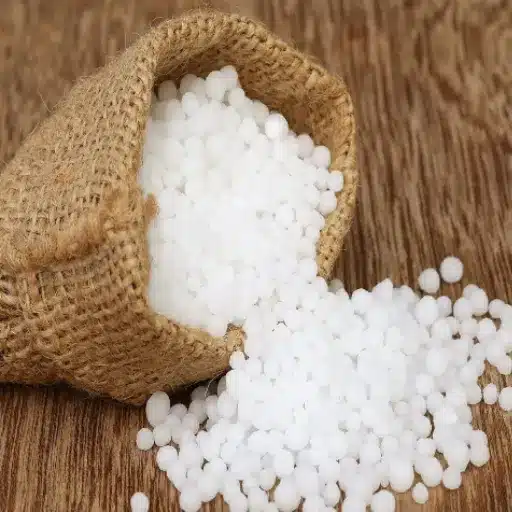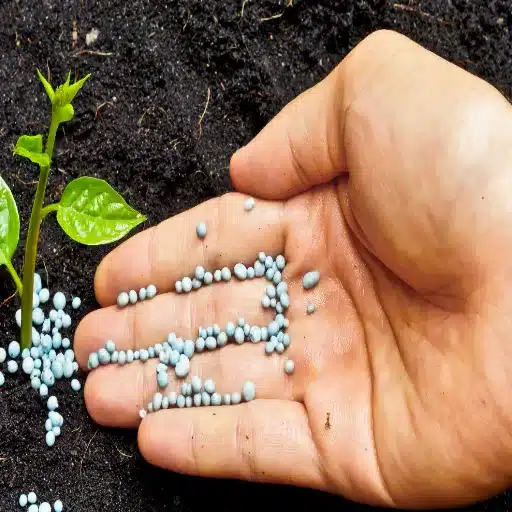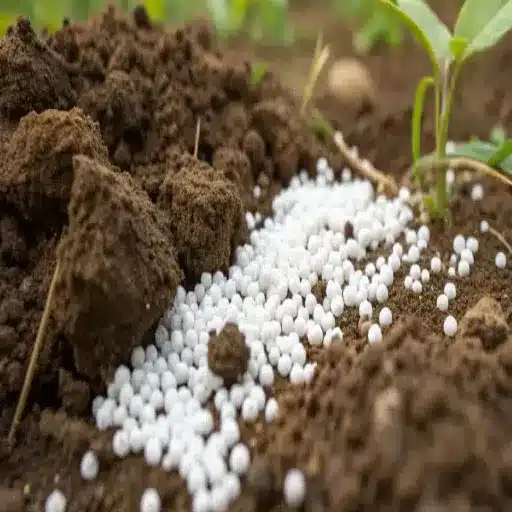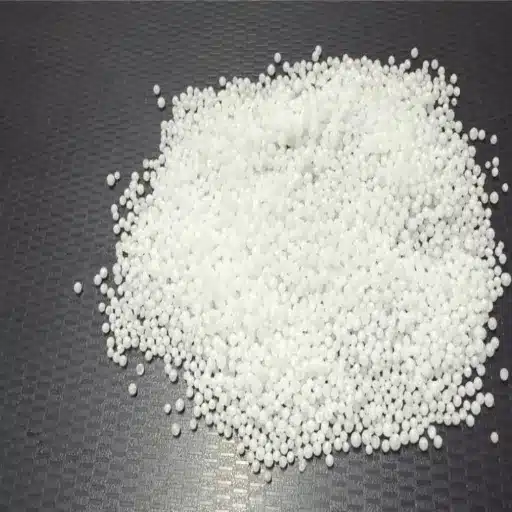Being one of the most commonly used nitrogen sources in agricultural activity worldwide, urea fertilizer is famous for its nutrient quality and cheapness. However, like making any other agricultural decision, it brings its own positives and negatives. This guide aims to describe urea fertilizer at length as it supports increased yields while considering potential problems with sustainable farming practices. Whether you are a farmer, an agronomist, or just someone interested in agricultural developments, this article will give you an authoritative report on the pros and cons of urea fertilizer to help you make an informed choice on its application.
Introduction to Urea Fertilizer

What is Urea Fertilizer?
Urea fertilizer is considered a highly concentrated nitrogenous fertilizer used in both promoting plant growth and enhancing crop yields. The fertilizer is made up of 46% nitrogen; thus, it remains among the cheapest and efficient forms of nitrogen fertilizers. Urea is synthetically prepared by reacting ammonia with carbon dioxide at elevated temperature and pressure to form a solid, granular product that is easy to handle and store.
The nitrogen contained in urea is made available for plant use in a process of natural hydrolysis. When urea is put in the soil, it goes on with the reaction with water and an enzyme called urease, which results in the release of ammonium that is absorbed by the plants. This makes it suitable for application during stages of intensive plant growth, especially for crops like corn, wheat, and rice with high nitrogen requirements.
While having benefits, the correct application of urea is key in averting drawbacks like loss of nitrogen due to volatilization or leaching. The efficacy of urea really depends on the timing of its application, the methods of application, and the soil characteristics. As part of a responsible agricultural approach, urea is an advantageous fertilizer option that offers enhanced food production when applied with due care toward environmental sustainability.
Chemical Composition of Urea
The common name of carbamide is urea, and it has a molecular formula of CH₄N₂O. Carbon, hydrogen, nitrogen, and oxygen are the elements constituting this transparent and crystallizable organic compound that is highly soluble in water. Two amine groups (–NH₂) are attached to a single carbonyl group (C=O) in the molecule; this structural arrangement renders urea an efficient nitrogen source.
| Component | Details |
|---|---|
| Molecular Formula | CH₄N₂O |
| Nitrogen Content | 46% by weight |
| Physical Form | Transparent, crystallizable, highly water-soluble |
Urea is nitrogenous, its agrochemical aspect being at 46 per cent by weight. This high nitrogen content has made urea one of the most popular nitrogenous fertilizers in the world. Upon application to the soil, urea undergoes hydrolysis to produce ammonium ions and carbonate that are subsequently absorbed by plants as nitrate or ammonium.
The chemical constitution of urea determines not only its suitability as a fertilizer but also its behavior under different environmental conditions. For example, the presence of a carbonyl group renders it highly reactive with water, making its application carefully controlled to minimize nitrogen losses through volatilization or leaching. A clear understanding of its structure and reactivity will aid in the efficient utilization of urea in agricultural settings.
Significance of Urea in Agriculture
Apart from its benefits in nitrogen fertilization worldwide in modern agriculture, which produces about 46% of nitrogen from urea, this element is a must for any plant’s growth: in protein synthesis, chlorophyll production, and interspersed crop development. It is in and of itself a very efficient nitrogen transporter, and hence this fertilizer stands as a competitor for other nitrogen-based fertilizers used worldwide, mostly in intensive agricultural systems.
The reasons for urea being important have an economic background: inexpensive manufacturing and application cost. It is easily stored and transported due to its solid, granular form and can be easily spread over huge agricultural terrains. Urea fertilizer application can be either direct or mixed with other fertilizers, thus being highly adaptable to various cropping systems. Moreover, it undergoes hydrolysis when in the soil, i.e., changes to ammonium and nitrate, in soils where nitrogen enters most readily into plants.
Urea has many advantages, but its efficacy must be maximized by proper management. In contrast to other fertilizers such as ammonium nitrate, urea cannot be applied on the surface without incorporation into the soil, as it would otherwise be lost largely to nitrogen through volatilization of ammonia. These losses can be prevented if the urea is incorporated into the soil, if urease inhibitors are used, or if the urea is applied just before rain. Understanding these nuances helps farmers derive the greatest benefits from urea while minimizing its environmental footprint and ensuring sustainable production in agriculture.
✅ Advantages of Urea Fertilizer

High Nitrogen Content
🌱 Key Highlight: Urea contains 46% nitrogen by weight, making it one of the most concentrated solid nitrogen fertilizers available.
Among the fertilizers that are nitrogenous and solid-form fertilizers, Urea possesses one of the highest nitrogen contents, usually implying 46% nitrogen by weight. This high nitrogen percentage means urea will be an efficient nutrient source. It is a cheaply procured fertilizer used to enhance crop growth and yield. Nitrogen remains the most essential element for plants because it is involved in processes such as the development of chlorophyll and the formation of proteins. Hence, urea acts as a highly concentrated source of nitrogen to fulfill the nutritional requirements for various crops under agricultural settings.
The efficiency of urea for nitrogen lies in its flexibility with respect to its application across agricultural systems. Urea applied directly to the soil or dissolved in water for use in irrigation is the most practical method for ensuring a uniform supply of nitrogen to crops. Urea is also compatible with other nutrients and can be mixed with phosphorus or potassium fertilizers to make balanced nutrient formulations. That way of applying nutrients gives farmers the ability to fine-tune nutrient delivery for their crops and thus promote optimal agricultural production.
It is important, nevertheless, to consider a few problems that may develop with urea application, including washing (leaching) and volatilization nitrogen loss, and others. Without well-established management techniques, losses lead to decreased nitrogen effectiveness and cause environmental issues such as groundwater contamination and greenhouse gas emissions. To prevent such environmental hazards, agricultural science has established urease inhibitors, slow-release fertilizer formulations, and precision application techniques that may achieve high nitrogen use efficiency at a low environmental cost. Among these innovations, urea stands as a sustainable fertilizer and a fertilizer of choice in present-day agricultural practice.
Cost-Effectiveness of Urea
Urea has been reasonably priced, aspreferring for use in agriculture, thus attaining popularity as a common nitrogen-based fertilizer all over the world. It carries a nitrogen content of about 46%, allowing it to be transported and stored in lesser quantities when compared to other fertilizers. The development of production technology has also proved to be efficient for urea synthesis, where economies of scale are also achieved, thus contributing to the drop in prices for end users.
Precision applications, such as variable rate technology (VRT), can thus reduce the cost per unit of nitrogen applied, minimizing waste and increasing crop productivity. Also, with the advent of enhanced-efficiency fertilizers (EEFs), such as polymer-coated urea, growers are presented with the opportunity to reduce their total fertilizer application without sacrificing productivity or even increasing it. Such developments have only strengthened the personality of urea as a cost-benefit fertilizer for small- and large-scale farming.
Various studies suggest that if made use of with urea, urease inhibitors, and nitrification inhibitors can actually pay for themselves as they reduce nitrogen loss through volatilization and leaching. This ensures nitrogen remains available for the crops and reduces eventual reapplication costs. Urea, still, continues to be an essential and fairly cheap building block of nutrient management strategies across the world as agricultural systems keep upgrading.
Boosting Agricultural Productivity
These days, nutrient management is done with the aid of precision agricultural technologies for maximum accuracy while urea is being applied. GPS-guided machinery, soil sensors, and variable rate technology (VRT) enable farmers to apply fertilizers according to the precise needs of the affected fields or even zones within fields. If wasted, neglected, or indiscriminately applied, it can lead to suboptimal plant production and excessive runoff plus leaching of nitrogen fertilizers into the environment.
Advanced modeling software and satellite imagery support decision-making analysis of crop health and soil nutrient profiles in real time. For instance, remote sensing may locate areas of nutrient deficiency so that remedial measures can be put in place to enhance the efficiency of plant uptake. Using such technologies together with urease and nitrification inhibitors allows farmers to greatly improve nutrient use efficiency and ensure that nutrients are supplied to crops in precise amounts at the best stages of crop growth.
Utilization of these tools leads to the maximization of production while also promoting sustainability in agricultural practices. By addressing derailment from depletion of natural resources and environmental deterioration, precision agriculture enables modern farming systems to produce more while spending less.
⚠️ Disadvantages of Urea Fertilizer

Environmental Impact
🚨 Critical Concern: Urea fertilizers have serious environmental implications that require careful management.
While supplying nitrogen efficiently to crops, the urea-type fertilizers have serious environmental implications that need to be addressed. The following highlights five major environmental problems caused by urea fertilizers:
1
Nitrous Oxide Production
Upon application onto soils, urea undergoes hydrolysis, releasing ammonia, which then gets converted to nitrous oxide via nitrification and denitrification. Nitrous oxide, with a global warming potential about 298 times that of Carbon Dioxide (CO₂), is considered a potent greenhouse gas.
2
Contaminating Water
Nitrate leaching occurs more often when one applies an excess amount of urea to land or does it improperly. Nitrates in drinking water are harmful, such that drinking water with elevated nitrate content entails the risk of methemoglobinemia (blue baby syndrome) in infants.
3
Ammonia Volatilization
The major part of the nitrogen from urea can be lost into the atmosphere as ammonia gas, especially in conditions of high temperature and alkaline soil. This loss decreases the efficiency of the fertilizer and contributes to air pollution and the generation of fine particulate matter (PM2.5).
4
Acidification of Soil
If applied continuously, urea fertilizer may cause soil acidification due to hydrogen ions being released during the nitrification process. Acidified soils are limed to correct the pH, thus adding to production cost and labor.
5
Effects on Aquatic Biotechnology
Runoffs from the fields that have been treated with urea can cause eutrophication in the nearby water bodies, with nitrogen concentrations triggering algal blooms which further deplete the oxygen levels, creating dead zones where no aquatic life can survive, which in turn disrupts biodiversity and ecological equilibria locally.
💡 Solution: In dealing with these environmental issues, optimal solutions do exist, which entail the practices of precision nutrient management, split applications, and the use of urease inhibitors to keep the environment safe from negative impacts while allowing agricultural productivity.
Soil Acidification and Nutrient Imbalance
In soil acidification, chiefly ammonium-based fertilizers and nitrate leaching, and crop nutrient uptake are responsible. These processes bring about in dilution of alkalinity and lower soil pH, making the landscape more hostile for plant growth and impeding the formation or availability of essential nutrients. Aluminum and manganese will dissolve more in acidic soils and are unfavorable for root development and nutrient absorption.
Very common nutrient imbalances arise when excessive fertilizers, inappropriate fertilization methods, or monoculture farming systems are used in agricultural practices. Excessive inputs of certain nutrients, such as nitrogen or phosphorus, can displace other essential nutrients, thereby interfering with soil chemistry and biological health. Recent studies have highlighted that these imbalances not only hamper plant production but also cause eutrophication downstream in aquatic ecosystems.
Besides lime application, soil amendments are also sometimes employed on a strategic basis under the prevention or correction of acidification and regular soil testing to check for any alteration in soil properties. ISFM measures in the case of nutrient imbalances include balanced fertilizer formulations, crop rotation, and integration of legumes in cropping systems, which enhance nutrients in a sustainable way. In this way, the soil remains fit for land productivity over time while environmental risks are mitigated.
Challenges in Proper Application
The already few and far-between successful executions of proper soil management practices face numerous obstacles. The most prehistoric hurdle is the variable nature of soils; therefore, optimal results can be attained only through site-specific approaches. Farmers usually do not have access to either accurate or reasonably priced soil-testing methods and end up antagonistically applying lime or fertilizers. If applied beyond limits, one carries the risk of causing environmental pollution by linkage in nitrate, while if insufficiently applied, nutrient deficiencies might remain severely unresolved.
Another significant challenge in adopting ISFM strategies is the dissemination of information on sustainable practices. Farmers, especially in resource-constrained area,s are unable to adopt modern approaches because of limited access to extension services and technical training. When farmers can’t afford to buy good-quality inputs and technologies like precision agriculture, finance becomes a bottleneck. And all these get aggravated by climate variability, which keeps growing conditions ever so unpredictable, hence soil management becomes a challenge to plan and implement.
To address the challenges, a mix of tailor-made education systems, research and development investment, and financial subsidies or incentives will need to be offered. Also, with the help of remote sensing technology and data-driven recommendations, it will be possible to ensure that soil management practices are implemented with precision, effectiveness, and environmental sustainability.
🎯 Best Practices for Using Urea Fertilizer

Optimal Application Techniques
🔧 Best Practice: Avoid surface application to minimize ammonia volatilization losses.
The application of urea fertilizers essentially boils down to the use under environmental conditions that favor nutrient uptake and possible nutrient loss; techniques that minimize ammonia volatilization via direct application to the surface should be avoided. Rather, a brief incorporation shortly after fertigation application would be beneficial. Incorporation methods, for instance, may include shallow tillage or irrigation, wherein the urea will be dissolved and incorporated into the root zone.
Another critical consideration is time; the main goal is to ensure that nitrogen application is well synchronized with the active growing period to ensure optimum uptake; further enhancement may be achieved through split applications, wherein urea fertilizer is applied in smaller amounts at critical growth stages, and the chances for losses through leaching or surface runoff occurring during heavy storms are reduced. Also, such losses can be curbed with urease inhibitors and slow-release formulations by delaying urea conversion to ammonia gas.
The precise application of fertilizer is now made possible by modern tools, namely variable rate applicators, soil testing, and GPS mapping, which ensure that the right amount of urea is applied at the right site. The technologies are said to improve nitrogen use efficiency by 20%, thereby cutting down costs and helping the environment. When properly used, these methods contribute to higher crop yields, preservation of soil, and sustainability in the long run.
Minimizing Nitrogen Loss
Actionable steps for nitrogen-loss reduction are necessary to improve agricultural productivity and counter environmental damage. One such major route for nitrogen loss is volatilization, whereby ammonium-based fertilizers are converted into ammonia gas and thus lost to the atmosphere. To mitigate this, if urease inhibitors, such as NBPT (N-(n-butyl) thiophosphoric triamide), are applied, ammonia release is greatly reduced because the substances inhibit the hydrolysis of urea. Other methods of limiting ammonia release into the atmosphere following nitrate fertilizer application include the incorporation of fertilizers into the soil.
Leaching is another pathway through which nitrogen is lost, where nitrates are carried through the soil profile, especially in sandy or well-drained soils. The use of controlled-release fertilizers can alleviate the problem, since such compounds are designed to release nutrients slowly, matching crop demand. Cover crops of rye or clover can further act as a biological barrier, thereby soaking up nitrogen in excess and holding it within the soil system.
Along with water application, nutrient loss can also be prevented by applying fertilizer using a micro-irrigation system and keeping irrigation to a minimum. Setting appropriate irrigation schedules along with fertigation may increase the nitrogen use efficiency, thereby minimizing runoff and leaching. In conjunction with remote sensing and real-time data analytics, maximum nitrogen retention can be secured for sustaining and economically viable farming operations.
Proper Storage Guidelines
| Storage Aspect | Requirements |
|---|---|
| Environment | Cool, dry conditions to avoid degradation or clumping |
| Protection | Away from sunlight and moisture |
| Containers | Tightly sealed to prevent contamination and nutrient loss |
| Safety | Away from flammable substances and unauthorized access |
Storage of agricultural inputs such as fertilizers, pesticides, and seeds is for the sake of conserving their quality, preventing any possible losses, and maintaining their safety standards. For fertilizers, some good storage conditions would be one that is cool and dry place, so as to avoid degradation or clumping, as sunlight and moisture could potentially harm the product. Containers must also be tightly managed to avoid contamination or to prevent a chance of loss of nutrients. Safety considerations come into play here as well; fertilizers must be stored away from any flammable substances or, preferably, places where children and unauthorized persons cannot reach.
Pesticides have to be stored in an environment with proper ventilation and temperature control to protect them from chemical breakdown or volatilization. They may be segregated and labeled according to their chemical nature to prevent accidental reactions. Seeds will be kept inside moisture-proof bags in low-temperature and low-humidity environments to keep their germination rate and viability over time.
Modern technologies can potentially further improve storage efficiency. Sensors and IoT monitoring systems can be installed to provide real-time information on environmental conditions inside storage cells, such as temperature, humidity, and gas emissions. With automated alerts and predictive analytics, the situation can be managed proactively, reducing losses and keeping the inputs in optimum conditions. When combined, these technologies bring a new level of precision and sustainability to resource management in farming, whether small or industrial.
📊 Conclusion: Weighing the Pros and Cons of Urea Fertilizer
Summarizing the Role of Urea in Modern Farming
🌾 Key Takeaway: Urea remains essential in modern agriculture but requires proper management for optimal results.
Urea is mainly a nitrogen fertilizer that is extensively used in modern agriculture due to its high nitrogen content, low costs, and ease of application. It fulfills a crucial role in plant development and maximal crop productivity, directly catering to the nutritional needs of high-intensity farming systems. Upon application to the soil as a fertilizer, urea undergoes hydrolysis to become ammonium carbonate and hence furnishes ammoniacal nitrogen for promoting vegetative growth and protein synthesis in plants.
However, the use of urea fertilizer also generates some disadvantages. Nitrogen is lost mainly because of improper application or unfavorable conditions such as high temperature or heavy rainfall. Nitrogen is lost to the atmosphere as a gaseous compound due to volatilization, or it is in solution with water and washes away through the soil profile as leachate or by surface runoff. A negative impact on the environment is enhanced because these gaseous compounds are greenhouse gases, and the leachates are polluting water bodies. Thus, advanced methods like urease inhibitors and precision applications are being set up to overcome such constraints and improve the nitrogen-use efficiency.
In addition, newer technologies in agriculture, such as soil sensors and decision support systems, allow for data-driven applications with special emphasis on certain crop and environmental situations. This integration thus ensures increased productivity and aligns with global initiatives for sustainability to reduce environmental impact and provide climate-resilient farming.
Insights into Sustainable Use of Urea
The concept of sustainable use of urea ties in with newer agricultural practices that ensure maximum utilization and minimal threat to the environment. Precision agriculture techniques, therefore, hold the key; by this technique, farmers apply urea to their fields depending on up-to-the-minute field data. GPS-guided applicators, variable rate technology (VRT), or the use of an unmanned aerial vehicle (UAV) application management system ensure uniform application of the fertilizer across the field, thus preventing problems arising from over-application and nitrogen leaching or volatilization.
At the same time, another approach is the use of urease and nitrification inhibitors to boost nitrogen retention in the soil and improve nitrogen-use efficiency (NUE) significantly. Research has shown that these inhibitors can increase crop yields by as much as 20% while reducing greenhouse gases (GHGs) by lessening N₂O emissions into the atmosphere.
In addition, crop rotation and intercropping practices help to enrich soil fertility/soils naturally, thus requiring minimal synthetic inputs such as urea. For instance, legumes fix atmospheric nitrogen into soils, building soil reserves, and maintain a more sustainable nutrient cycle. These holistic approaches provide an environment for urea to work most efficiently and to cause the least harm to the environment, especially when combined with proper irrigation management to avoid waterlogged conditions.
If they continue to implement these technologies and methods, farmers will move toward balancing the sacrosanct house of capacity with environmental stewardship. Sustainable management of urea-based agricultural systems is not just a scientific imperative but also crucial to global food security strategies for the future.
Future Perspectives on Urea Fertilizer
The integration of advanced scientific innovations that seek to minimize the environmental footprints of urea fertilizers while enhancing their agricultural productivity holds the future of urea fertilizers. Activation of sustainable use of urea would require adopting enhanced efficiency fertilizers (EEFs) that help in reducing nitrogen losses via volatilization and leaching. Processes, including the use of urease inhibitors and nitrification inhibitors, are increasingly making use of the slow-release nitrogen sources that will ideally keep pace with crop demand. Such development also responds correctly to the international desire for excess nitrogen to be prevented from entering waterway eutrophication and GHG emissions.
One instance is the new age of fertilizer application introduced by precision agriculture. With remote sensing technologies used by drones and decision support systems for nutrient management, farmers may apply fertilizers with extreme accuracy. To mention one, variable rate technology (VRT) achieves optimized rates of fertilizer application by analyzing soil nutrient maps and matching it with crop demands. As such, the level of precision avoids wastage of urea and ensures that nitrogen is used efficiently for better crop yields and reduced cost. Supported with machine learning and AI algorithms, these methods will continually improve the prediction and adaptability of fertilizer application strategies.
In conclusion, the integration of urea with bio-based additives and organic amendments is a cutting-edge subject of research. These additives improve nitrogen use efficiency by stimulating microbial activity in soils as well as stabilizing urea. The second way in which these technologies can be tried is in the formulation of slow- and controlled-release urea, which serves to buffer an intermittent nutrient uptake by crops. The future of urea fertilizer may thus finally contribute to food security and environmental conservation as we observe the formation of technological products, data-driven insights, and eco-friendly policymaking.
❓ Frequently Asked Questions (FAQ)
In the first place, urea fertilizer with a high nitrogen concentration supplies nitrogen to the plants, fostering their growth. It is an inexpensive nitrogen fertilizer and is easily applied to the soil. Other advantages include that urea is available in various forms, like solid granules or a liquid solution. Besides, urea acts quickly in releasing nitrogen to plants, thus increasing crop yield and nutrient use efficiency.
The inadequacies of urea comprise potential nitrogen losses in the form of emissions as ammonia gas and washing away into water bodies. If used excessively, urea acidifies the soil and results in harm to the health of the soil. Moreover, inadequate application of urea results in an uneven distribution of nutrients, the other adverse effect that can lead to poor bearing in plants. Therefore, farmers must carefully analyze urea application to limit its drawbacks.
Urea acts as a nitrogen source through a chemical process in which urea is converted into ammonia and ammonium ions in the soil. Soil microorganisms carry out the breakdown when urea is applied to the soil. Nitrogen that is released then becomes available for plant uptake, making urea a common nitrogen fertilizer for many crops.
Urea is a good nitrogen fertilizer and is better applied along with other fertilizers, such as those containing potassium and phosphorus, to complete the nutrient requirements of the plants. When used alone, urea may not supply all the essential nutrients needed for plant growth; hence, it makes sense to use it as one of the components in balanced fertilization.
Urea fertilizer is especially advantageous to those crops requiring high nitrogen content, namely cereals, corn, and leafy vegetables. High nitrogen content in urea serves the growth and yield of these crops. However, the efficiency of urea depends on the soil conditions and the time of application.
For nitrogen fertilizer like urea, it should be incorporated into the soil immediately after application to limit nitrogen loss by volatilization. Another important consideration for farmers is the timing of urea application, so that it coincides with the periods critical for nitrogen required by the crop to ensure nitrogen availability to the plant when it is most required.
Urea fertilizer can be environmentally friendly provided that it is used responsibly. Proper application techniques can reduce nitrogen loss to the atmosphere and reduce the possibility of water pollution. However, using it excessively or with poor management may cause adverse environmental impacts, such as promoting greenhouse gas emissions and runoff problems.
Fertilizer alternatives to urea include organic fertilizers, namely compost and manure, which give a more balanced nutrient spectrum. Other nitrogen sources include ammonium nitrate and other nitrogenous fertilizers that are slow in releasing nutrients. The choice of a fertilizer largely depends upon the nutrient requirements of the crops and the prevailing soil conditions.
📚 References
- Urea Deep Placement – A method utilized for the application of nitrogen fertilizers. This method has been subjected to in-depth analysis regarding its environmental impacts.
- Assessment of Enhanced Efficiency Urea Products on Maize in Missouri – This study analyzes methods to reduce urea loss through volatilization and leaching, with special emphasis on improved efficiency urea products.
- Fertigation: Injection of soluble fertilizers into the irrigation system – This research discusses fertigation as a modern method of fertilizing, including urea fertilizing in container nurseries.







